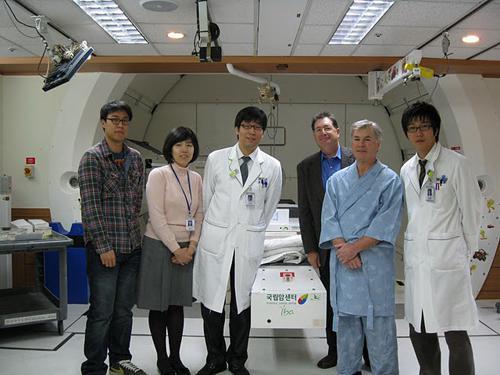When Svante Ebbinghaus of Sweden decided to go for another operation for his spinal pains that left him virtually unable to move without assistance, he had to quickly find a doctor. Research led him across the globe to South Korea.
“I remember it being so bad that my entire lower body was in excruciating pain,” Ebbinghaus, a 73-year-old orthopedic surgeon, recounted. “I had no choice other than to go in for a fourth operation, but my doctor was away at the time so I had to look for alternatives.”
He researched medical facilities around the world before finally resting his sights on South Korea, where he had read about the country’s radical advancement in technology. He discovered Wooridul Spine Hospital and soon began corresponding through email and telephone with a coordinator there.
He was put in the hands of physician Jang Jee-soo, president and chief surgeon at Wooridul. Jang has performed numerous similar, documented cases and written many papers on the progression of spinal surgery throughout the last several years.
Korea has been gaining considerable ground in securing leading medical technologies to help ease painful symptoms, particularly in the areas of spinal care and advanced cancer research and prevention.
“Korea’s medical specialists and technologies are some of the most advanced in the world, particularly in the field of minimally invasive spinal surgery,” Jang said. “By using a minimally invasive approach that includes endoscopic and image guided procedures, recovery times are reduced significantly and there is far less risk for complication.”
Older, more intrusive surgical methods required a large incision and fusion or fixation to the intervertebral disc joint, resulting in blood loss, normal tissue disruption and consequently leading to an elongated period for recovery or rehabilitation. All of those factors have now been abolished.
Jang notes that although many patients would like to avoid such clinical methods, those with severe spinal pathology often cannot be fully healed with non-surgical measures such as pain intervention, chiropractic or physiotherapy. Clinical methods are far more accurate and also drastically reduce radiographic exposure.
And with technological advancements making it even safer for patients, Jang reveals that both endoscopic spinal surgery and image-guided spinal surgery are two procedures that have made incredible progress.
Such advancement is evident in recent growing global interest; Wooridul Spinal Hospital has seen the number of foreign patients more than double within the last five years.
“Fusion enhancing or disc regenerating materials are still highly priced for commercial use,” Jang admits. “But with intensive research and investigation currently underway, costs will drop in the very near future.”
Another field of expertise where Korea is showing significant signs of improvement is in cancer research.
Curtis Poling, CEO of KMI International USA, was a victim himself. He was diagnosed with prostate cancer at 53.
He survived the ordeal thanks to Korea’s proton therapy and for the last several years has been using his background in senior management and business development of Fortune 500 companies in creating global awareness for Korea’s advanced cancer research.
 |
Douglas Henry (second from right), Proton Korea’s first patient, who beat cancer. (Yonhap News) |
“Proton therapy can use higher doses to kill cancerous cells than traditional radiation therapy (using X-ray technology), which kills many surrounding healthy cells and tissues, leading to potentially harmful and painful side effects,” Poling said.
“The major advantage of proton treatment over conventional radiation is that the energy (due to the Bragg peak) distribution of protons can be directed and deposited in tissue volumes designated by the physicians, in a three-dimensional pattern from each beam used. This capability provides greater control and precision and, therefore, superior management of treatment with minimal or no side effects while killing the cancer.”
Since March 2010, KMII has pioneered and created awareness in over 100 countries and 1,764 cities about proton therapy in Korea.
Already it has attracted a significant amount of interest from Canada, the U.K., U.S., South Africa, Argentina and the Philippines.
As of December 2010, 648 patients had been treated. Those numbers are expected to reach 900 by the end of the year.
It also helped that the Korea Tourism Organization has been getting the word out in an aggressive online campaign ― through sponsored reports in publications such as Forbes Asia together with a platform of blogs, online cancer groups and active membership with organizations such as the National Association for Proton Therapy.
“The real future force in patients discovering Korea will be referrals by past patients,” says Jin Soo-nam, executive director of medical tourism at the KTO. “Positive experience is the real driver to growth and we are seeing that with an annual patient reunion being held this month at the NCC proton center.”
Hans An van Roijen from Holland and Robert Galea from Argentina were diagnosed with prostate cancer and came to Korea for proton therapy. Both had considered alternatives but were aware of the complications.
“I considered other forms of treatment,” Galea recalls, “but they all had a high risk of side effects, including impotence, urine and colon damage.”
Their daily visits were no longer than half-an-hour, prep time included. Roijen and Galea returned home without any side effects.
What’s on the horizon is even more promising. Early next year, Korea will introduce a new technology called IMPT (intensely modulated proton therapy) designed specifically to target more complex tumor shapes, particularly in the head, neck and abdomen that are curved - and tumors that are aggressively wrapped around the spinal cord or brain stem.
IMPT will be able to shape complex fields with a limited number of radiation angles, which ultimately keeps the treatment time as short as possible and helps spare healthy tissue.
More appealing is that all these breakthroughs will soon be more cost efficient for patients.
(Yonhap News)








